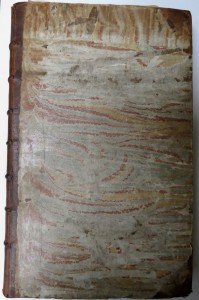
Jonathan Clark Fine Books
Art and Architecture
CHIPPENDALE, Thomas.
The Gentleman and Cabinet-Maker's Director: Being A Large Collection of the Most Elegant and Useful Designs Of Household Furniture, In the Most Fashionable Taste. Including a great Variety of Chairs, Sofas, Beds, and Couches; ... And Other Ornaments. To Which Is Prefixed A Short Explanation of the Five Orders of Architecture; With Proper Directions for executing the most difficult Pieces, the Mouldings being exhibited at large, and the Dimensions of each Design specified. The Whole comprehended in Two Hundred Copper-Plates, neatly engraved. Calculated to improve and refine the present Taste, and suited to the Fancy and Circumstances of Persons in all Degrees of Life.
London, Printed for the Author, and sold at his House, in St. Martin’s Lane; Also by T. Becket and P.A. De Hondt, in the Strand. 1762.
Folio. Contemporary or original half calf over Dutch combed marbled paper-covered boards, morocco and gilt label to the spine; ( [iv], title-page, preface) + 20pp. + engraved dedication leaf to the Earl of Northumberland, 200 finely engraved plates, with an additional 12 engraved plates of alternative designs. The placement of the twelve alternative plates is as follows: 25,36,45,49,67 (bound after 77), 68, (bound after 77), 153,159,167 (bound after 169), 171,179 and 187. All dated alternative plates are here in their earlier state (Morrison H. Hecksher). Plates 146-149 are mis-numbered 146,146,147,149.
The third and best edition with twelve extra plates.
Provenance: Sir William Beauchamp-Proctor, Bt. (1722-1772) of Langley Park, with his engraved armorial bookplate. Langley Park was built in the early 1730s for Richard Berney before being purchased by George Proctor, who commissioned Matthew Brettingham to remodel the structure in the Palladian style. In 1785 the estate passed to Sir William who completed the building and in 1765 commissioned Lancelot ‘Capability’ Brown to design the park. Finally, in 1785, Sir John Soane was called in to design new lodges for the entrances to the serpentine carriage drives that defined the perimeter of the park.
As Christopher Gilbert notes in The Life and Work of Thomas Chippendale, ‘It would be difficult to exaggerate the importance of Chippendale’s Director as a formative influence on mid-eighteenth-century furniture styles. His designs were truly popular in the broadest sense, for in addition to finding favour with the people for whom they were intended - the English aristocracy - they were rapidly assimilated into the native vernacular tradition, adopted in the colonies, influenced eminent European cabinet-makers such as David Roentgen, and even enjoyed a fashionable revival during the Victorian period’
Christopher Gilbert. The Life and Work of Thomas Chippendale. 1978.
Stock number: 1137
